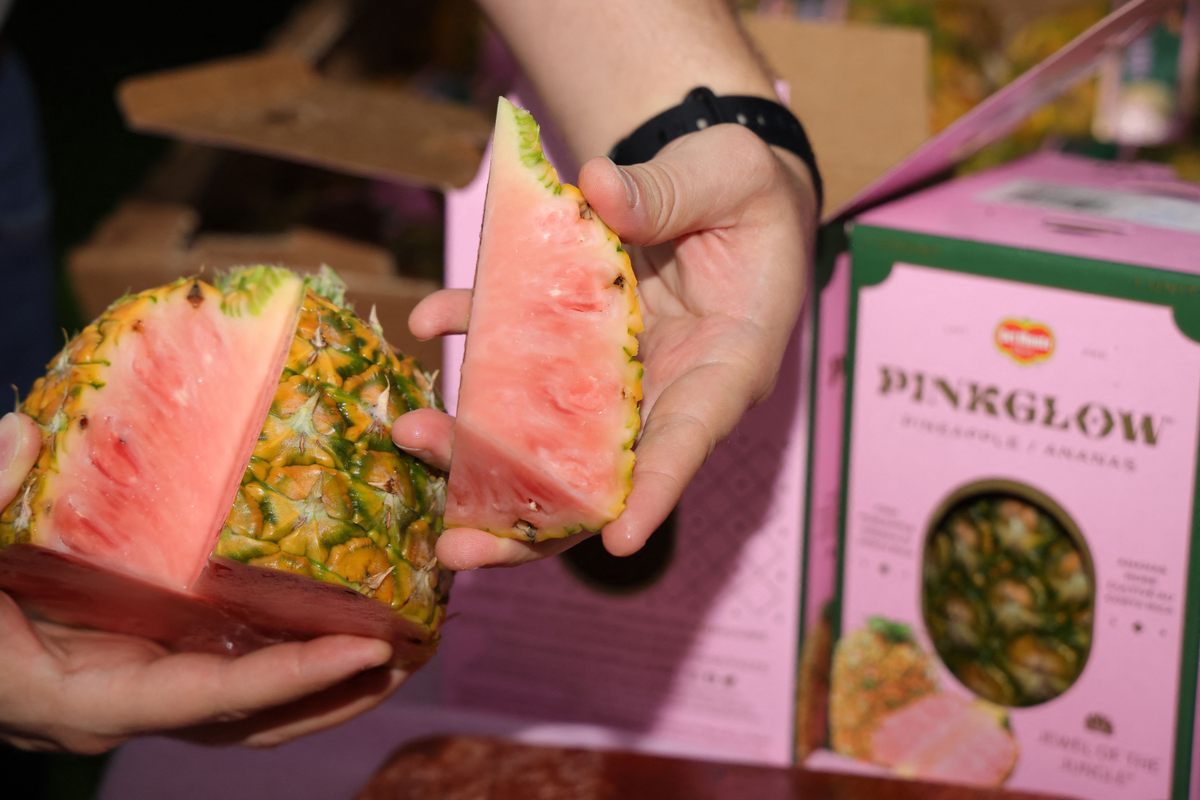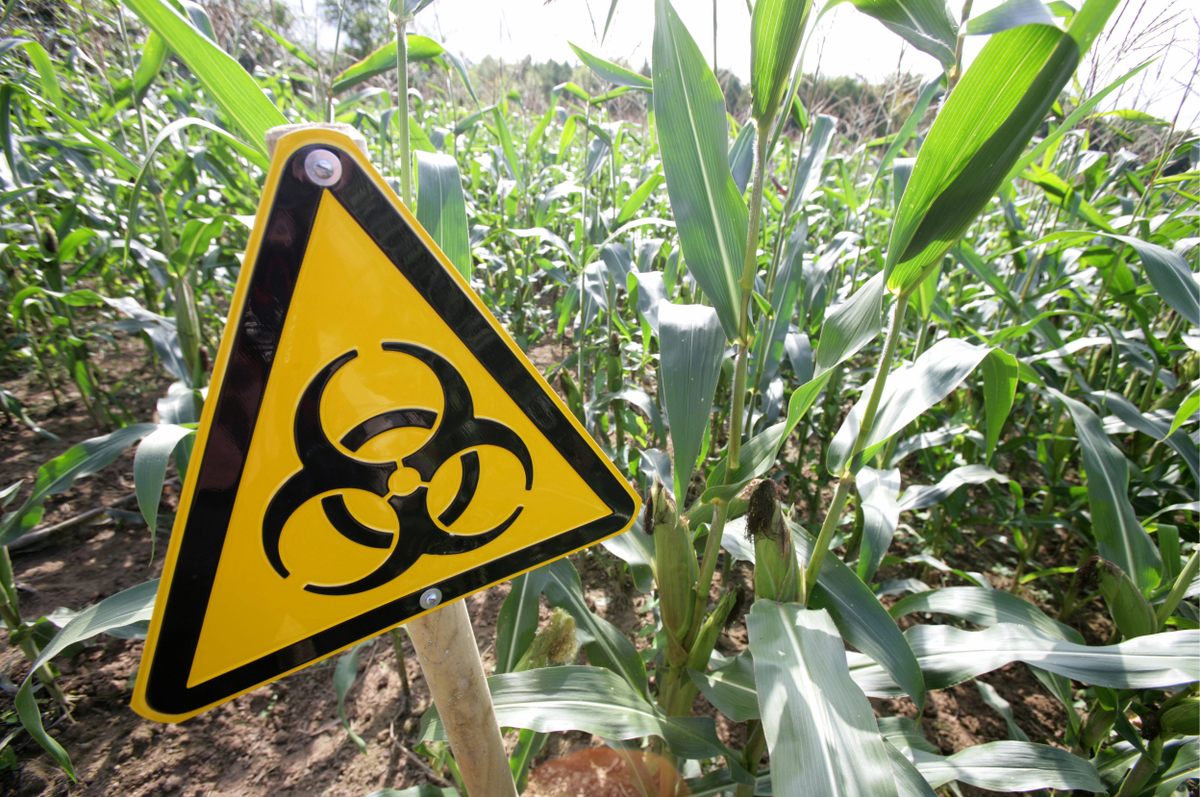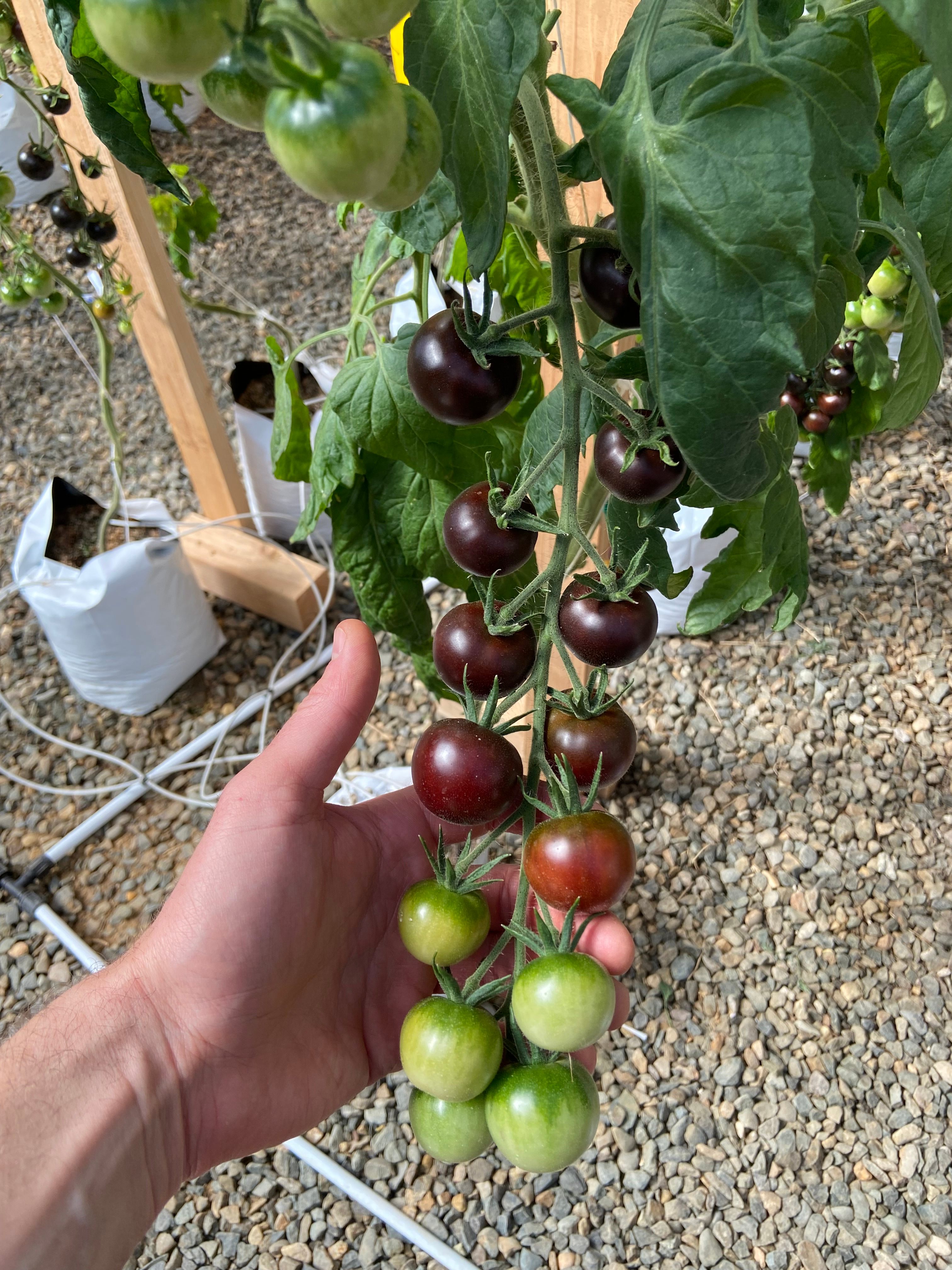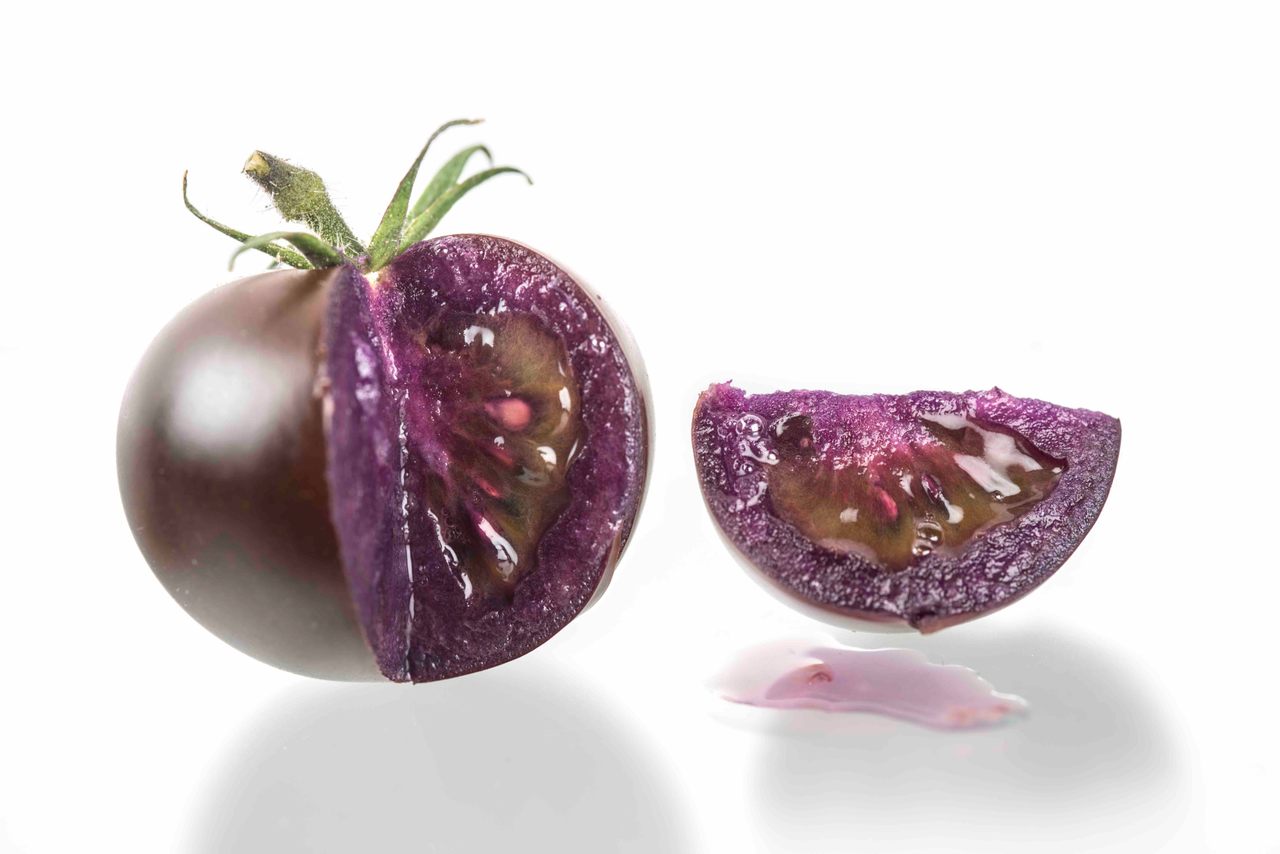Would You Eat This Purple Tomato?
This fruit owes its luminous violet shade to snapdragon flower DNA.
It looks like the kind of nightshade one might grow in Fern Gully, a lustrous, near-black tomato veined with bursts of alien fuchsia. Baker Creek Heirloom Seeds, a Missouri-based seed company, has a long history of offering strikingly photogenic heirloom tomatoes. From Queen of the Night, an orange-flecked beauty, to the California Tulip, a flame-hued Russian cultivar, to the Orange Accordion, a monster-sized, pleated number, the company’s past seed catalogs overflow with fantastical fruit.
But customers thought that there was something different about the Purple Galaxy. This suspiciously vibrant specimen bore an uncanny resemblance to another variety known as the Purple Tomato developed by Norfolk Healthy Produce. This wouldn’t be a big deal, except that the Purple Tomato’s coloring comes from snapdragon flower genes—a clear violation of Baker Creek’s strict policy against GMOs.
On February 19, Baker Creek abruptly pulled the Purple Galaxy from their 2024 lineup and issued a public statement on Facebook. “Although we understand that you—like us—may be disappointed not to have a delicious non-GM purple flesh tomato in your garden, we are pleased that we were able to make this decision before a single seed of Purple Galaxy was made available to customers,” the post reads.
Baker Creek alleges that they believed that they were purchasing non-GMO tomato seeds from a plant-breeder in the European Union. The company’s statement also notes that testing could not definitively establish a link between their Purple Galaxy and Norfolk Healthy Produce’s Purple Tomato, but that “the testing also did not conclusively establish that the Purple Galaxy is truly free of any genetically-modified material.” (Baker Creek did not respond to requests for comment.)
Norfolk Healthy Produce released a different statement on its FAQ page. “We are told that laboratory testing determined that it [the Purple Galaxy] is, in fact, bioengineered (GMO).”
“It’s not clear to me exactly what happened with the Purple Galaxy and that’s really Baker Creek’s business,” says Nathan Pumplin, CEO of Norfolk Healthy Produce. He personally has had no problem eating salads full of his company’s Purple Tomato. “I find it has a very savory, earthy flavor,” Pumplin says. “It’s fairly low in acid so, of course, the sweetness really comes through.”

All the fuss over this tomato cuts to the heart of a decades-long debate over genetically-modified foods and the role they should play in the American food system. Currently, only a very small number of genetically-modified plants, such as the Bt corn available at Harris Seeds, are available to home gardeners. Norfolk’s Purple Tomato is one of the first to be specifically marketed to them.
It’s also the culmination of nearly two decades of work, mostly on the part of Cathie Martin, a professor of plant sciences at University of East Anglia in the U.K. and a researcher at the John Innes Centre, Norwich. In a 2021 interview with The New York Times, Martin said, “There’s just so much baggage around anything genetically modified. I’m not trying to make money. I’m worried about people’s health! But in people’s minds it’s all Dr. Frankenstein and trying to rule the world.”
Due in part to her type one diabetes, Martin has a personal as well as scientific interest in making a healthy tomato. The purple plant is packed with powerful, cancer-fighting anthocyanins, the same compounds found in blueberries, purple cabbages, and plums.
GMOs have been integrated into the United States’ food supply since the early 1990s. The majority of these wind up in animal feed rather than directly on human tables. Usually, genetic modifications are practical—higher crop yields, resistance to diseases or pests, or tolerance of herbicides—although a few, like the lycopene-rich Pinkglow Pineapples and Arctic Apples, which refuse to brown long after they’ve been cut, are cosmetic.
One way or another though, just about everyone living in the U.S. has eaten GMOs, whether they were aware of it or not. According to the USDA, in 2020, 92 percent of all corn and 94 percent of all soybeans planted in the United States were GMO crops. Historically, public skepticism towards GMOs has run high. An oft-cited 2020 Pew Research Center survey found that 48 percent of those interviewed thought that GMO foods were unsafe.

“People think that we sit here with syringes and inject pesticides and horrible things into the fruit that they’re going to eat and that’s very far from the truth,” says Pumplin. In the case of the Purple Tomato, bacteria were used to insert two snapdragon genes into tomato plants, which then reproduced naturally for several generations. “At the end of the day, we’re still breeding plants and farming the way that people have done for thousands of years. We’ve just added a little biotechnology piece.”
Many early critiques of GMOs centered around Monsanto’s “terminator seeds,” a program by which the agrigiant stripped seeds of their ability to germinate naturally and prosecuted farmers for practicing generations-old seed-saving techniques. These seeds were never made commercially available and the program was discontinued in 1999 under immense public pressure, but the stigma associating GMOs with nefarious Big Ag schemes persisted.
“I think you need to look at each genetically-engineered plant on a case-by-case basis and determine what the benefits are, what the possible risks are,” says Raoul Adamchak, who oversees UC Davis’s CSA program.
Both Adamchak, an organic farmer of more than 30 years, and his wife, Pam Roland, a plant geneticist and professor of plant pathology at UC Davis, have been deeply invested in the conversation around GMOs for decades. In 2008, the two coauthored Tomorrow’s Table: Organic Farming, Genetics, and the Future of Food. Much like Norfolk Healthy Produce and Baker Creek, the couple might initially appear to occupy opposite sides of an ideological gulf.
“A lot of people wonder if Raoul and I can be friends—if we can even talk to each other,” Roland told the audience in a 2014 presentation at UC Berkeley. She was sharing the stage with author Michael Pollan, at the time a staunch critic of GMOs. “We can because we have the same goal.”

That goal is a more abundant, secure food supply for an increasingly volatile world. Roland’s work centers on genetically-enhanced rice varieties that can survive floods, sequester carbon, and more. “If you have rising oceans, you’re going to need salt-tolerant crops,” Adamchak says. “There are people working on virus-resistant plants and insect- and disease-resistant plants. So I think that all of this can be very beneficial in the future as agriculture just gets more and more challenges due to climate change.”
As Adamchak points out, there are already plenty of instances of GMO crops that have been beneficial. For instance, biotechnology essentially saved Hawaiʻi’s papaya industry from being wiped out by the ringspot virus, while pest-resistant biotech eggplants are being used to help fight hunger in certain areas. “There’s not a huge list, but there’s a list,” he says. “And you can see historically that there haven’t been any negative effects on people’s health from it.”
While genetically-modified organisms come with risks, “I don’t see any more risk from genetic engineering or from CRISPR than we’ve had from plant-breeding,” Adamchak says. Many plants naturally contain toxins or allergens, which could creep into a new variety if a plant breeder is not careful. “The same goes for genetically-engineered plants, but they’re so scrutinized that they’re, in a way, less likely to cause those sorts of problems.”

At present, GMO crops need to make it through a serious amount of red tape in order to get to market. Although Martin successfully made her purple tomatoes in 2008, it took another 14 years to get USDA approval. Norfolk’s Purple Tomato will begin rolling out at select locations around the U.S. this year, with the aim for a wider distribution by 2025.
“One really fun thing, I think, about the Purple Tomato is that it’s not exactly the first [GMO] seed that a home gardener could buy, but pretty close,” Adamchak says. “It opens the door to thinking about what the possibilities are and maybe opens people’s minds to be more accepting of genetic plant improvement.”
At the end of the day, if the Purple Tomato is going to stick around, he says it will need to be more than a curious science experiment. He points to the Flavr Savr tomato, the first commercially grown GMO food for human consumption, which was released in the U.S. in 1994. The tomato was engineered to have a longer shelf-life, but its bland, mealy flesh paled in comparison to a good heirloom tomato. As Adamchak points out, the brand name became a punchline. “[Calgene became] the straight man setting people up to make jokes about the flavor.”
That’s why Adamchak plans to grow his own. Although Norfolk Healthy Produce sold out of all 13,000 orders of Purple Tomato seeds, he reached out and managed to get a few for his own organic garden. “I’m curious how the plant grows and how it tastes and how it looks,” he says. “It’s one thing to say it has anthocyanins and it’s going to be healthier for you, but if it doesn’t taste good, people aren’t going to buy it.”
Gastro Obscura covers the world’s most wondrous food and drink.
Sign up for our email, delivered twice a week.

































Follow us on Twitter to get the latest on the world's hidden wonders.
Like us on Facebook to get the latest on the world's hidden wonders.
Follow us on Twitter Like us on Facebook